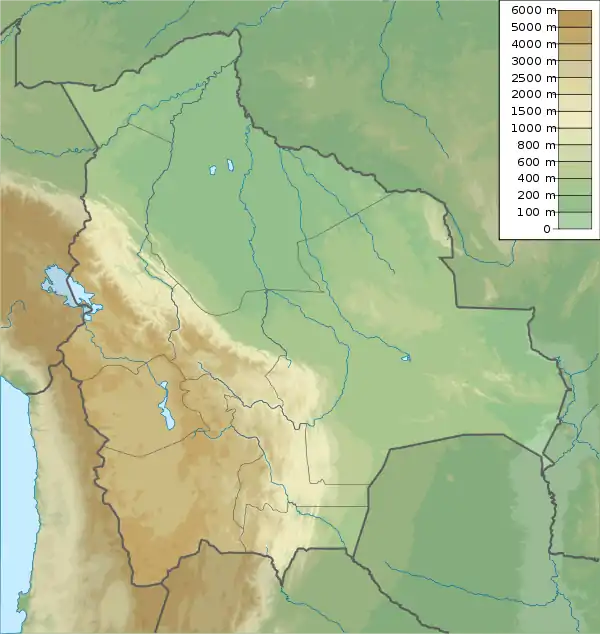San Benito Formation, Bolivia
The San Benito Formation is a Katian geologic formation of central Bolivia. The formation belongs to the Cochabamba Group, overlies the Anzaldo Formation and is overlain by the Cancañiri Formation. The 500 metres (1,600 ft) thick formation comprises a succession of shallow water quartzitic sandstones with minor interbeds of dark grey micaceous siltstones. Shelly fossils have been found at few horizons and consist mainly of linguliformean brachiopods, bivalves, and a few homalonotid trilobite remains. Poorly preserved graptolites occur occasionally in the shaly beds.[1]
| San Benito Formation Stratigraphic range: Katian ~460–446 Ma | |
|---|---|
| Type | Geological formation |
| Unit of | Cochabamba Group |
| Underlies | Cancañiri Formation |
| Overlies | Anzaldo Formation |
| Thickness | 500 m (1,600 ft) |
| Lithology | |
| Primary | Sandstone, siltstone |
| Other | Shale |
| Location | |
| Coordinates | 17.0°S 66.0°W |
| Approximate paleocoordinates | 45.6°S 126.6°W |
| Region | Cochabamba Department |
| Country | |
| Extent | Cordillera Oriental |
| Type section | |
| Named for | Cerro San Benito |
 San Benito Formation, Bolivia (Bolivia) | |
Fossil content
The formation has provided the following fossils:
- Desmochitina minor
- Rafinesquina pseudoloricata
- Tunariorthis cardocanalis
- Villosacapsula setosapellicula
- Ancyrochitina cf. ancyrea
- Hirnantia cf. transgrediens
- Rhabdochitina cf. magna
- Bistramia sp.
- Ctenodonta sp.
- Lingula sp.
References
- Sikhiri River at Fossilworks.org
Further reading
- J. L. Benedetto. 2013. Upper Ordovician Brachiopods from the San Benito Formation, Cordillera del Tunari, Bolivia. Ameghiniana 50(4):418-428
- R. Suárez Soruco. 1976. El sistema ordovícico en Bolivia. Revista Tecnica YPF Bolivia 5(2):111-123
This article is issued from Wikipedia. The text is licensed under Creative Commons - Attribution - Sharealike. Additional terms may apply for the media files.
